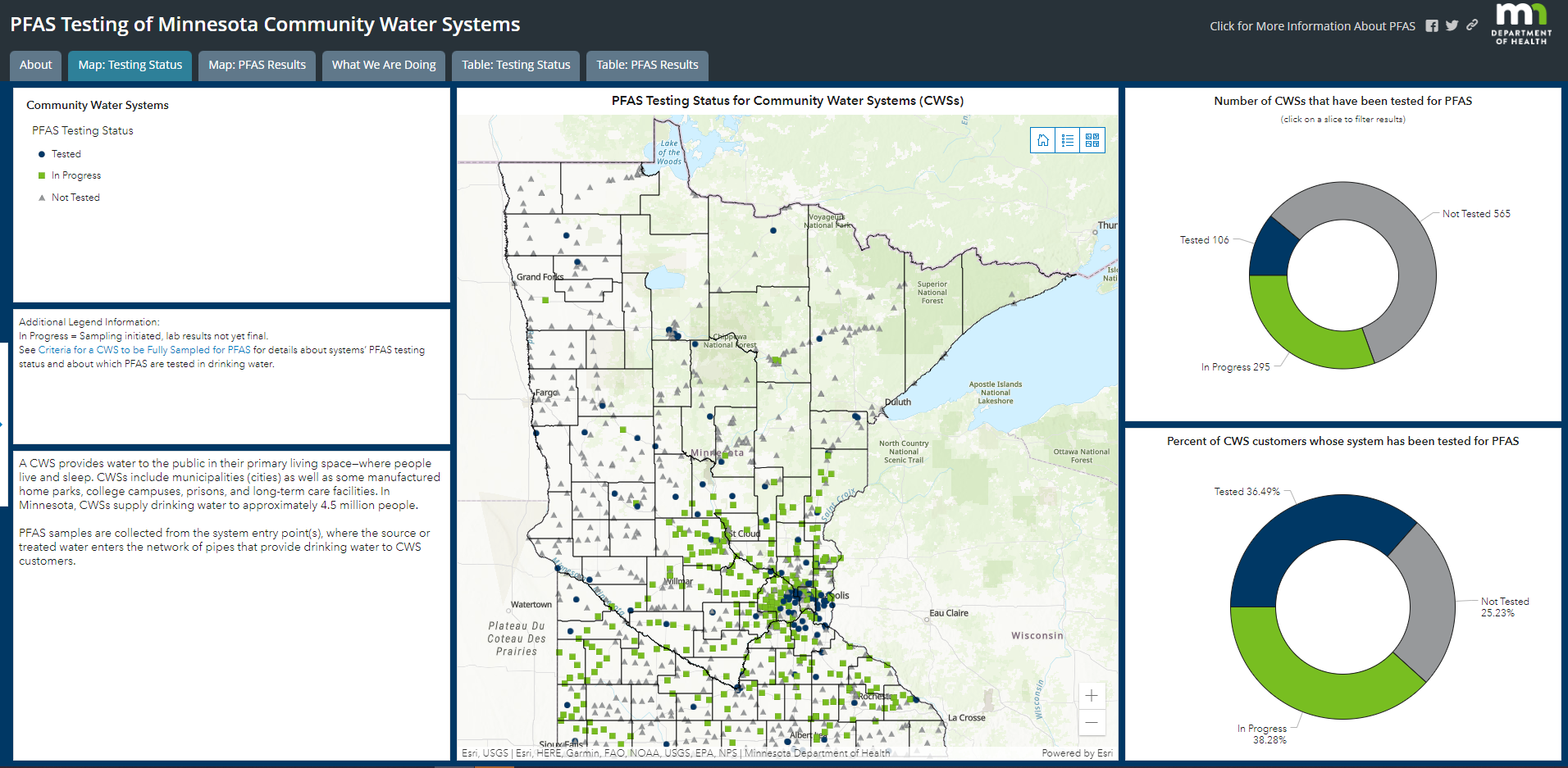Drinking Water Protection
- Drinking Water Protection Home
- About Us
- A-Z Index of Contaminants in Water
- Community Public Water Supply
- Drinking Water Grants and Loans
- Drinking Water Institute
- Drinking Water in Schools and Child Cares
- Drinking Water Revolving Fund
- Laws and Rules
- Noncommunity Public Water Supply
- Source Water Protection
- Water Operator and Certification Training
- Drinking Water Protection Contacts
Related Topics
- Annual Reports
- Drinking Water Risk Communication Toolkit
- Drinking Water Protection External Resources
- Fact Sheets
- Forms
- Invisible Heroes Videos: Minnesota's Drinking Water Providers
- Noncom Notes Newsletter
- Sample Collection Procedures (videos, pictures, written instructions)
- Waterline Newsletter
Related Sites
- 10 States Standards
- Clean Water Fund
- Health Risk Assessment – Guidance Values and Standards for Water
- Minnesota Well Index
- Water and Health
- Wells and Borings
Environmental Health Division
Interactive Dashboard for PFAS Testing in Drinking Water
MDH has tested for per- and polyfluoroalkyl substances (PFAS) in community water systems (CWSs) across the state.
Our Interactive Dashboard for PFAS Testing in Drinking Water shows the status and results of PFAS testing for CWSs in Minnesota. In the dashboard maps, you can see each CWS's PFAS testing results.
If users find that data are not loading on the dashboard map, zooming in on the map will help the dashboard data load faster.
- How to use the interactive dashboard
- Information in the dashboard
- What do the PFAS testing results mean?
- For more information
Printable Information Sheets
PFAS in Drinking Water (PDF) (English) | PFAS nyob hauv Cov Dej Haus (PDF) (Hmong) | PFAS ku jirta Biyaha la Cabo (PDF) (Somali) | PFAS en el agua potable (PDF) (Spanish)
How to use the interactive dashboard
In the dashboard maps, you can:
- Navigate to an area by zooming in and out or moving the map with your mouse;
- Click on a CWS to view more information about it as well as its PFAS results;
- Use the left side panel to search for CWSs by county;
- Show the legend on the map; and
- Change the basemap.
Information in the dashboard
The About tab contains information about PFAS and testing for drinking water.
The EPA Standards tab shows the PFAS testing results for individual CWSs in relation to EPA's MCLs, including whether or not the combined PFAS results exceed the Hazard Index.
The tab, What We Are doing, contains more information about actions CWSs and MDH take to reduce PFAS in drinking water. It also has links for more information.
What do the PFAS testing results mean?
On the EPA standards tab, if PFAS levels are at or below the MCL, the PFAS levels in drinking water are considered safe for most people for drink. People of a certain age or with special health conditions may need to take extra precautions, like for a fetus or infants.
Drinking water with PFAS test results above the MCL poses a potential health concern. It does not represent an immediate health risk. Drinking water guidance and standards are developed to protect people from health effects over a lifetime of exposure.
CWSs with elevated PFAS can take actions to provide drinking water with PFAS levels that are as low as possible. These actions include shutting off the most contaminated wells, using wells that are clean or have lower levels of PFAS, blending water from their wells to minimize PFAS levels in drinking water, or installing treatment for PFAS.
More information about PFAS and health effects, treatment, and private wells can be found at Per- and Polyfluoroalkyl Substances (PFAS).
For more information
Contact health.drinkingwater@state.mn.us or the CWS with questions about individual systems and their results. Contact health.risk@state.mn.us with questions about PFAS health risks.
- To learn more about this project, see:
- PFAS Testing in Public Water Systems
For more information about PFAS, see Per- and Polyfluoroalkyl Substances (PFAS).

